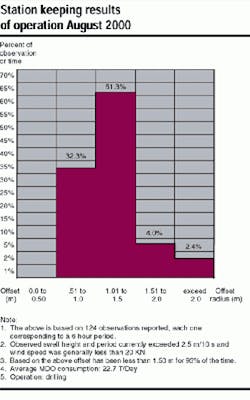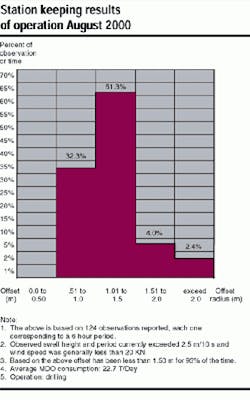WEST AFRICA: DGPS scintillation, signal degradation only challenges for new DP drillships
Pride Africa and Pride Angola, the latest additions to Pride International's drillship fleet, have performed well during initial operations offshore Angola, but the dynamic positioning (DP) capability still needs fine-tuning. Pride's Olivier de Bonnafos and Chris van Liefde outlined experiences to date at the Station Keeping seminar in the Netherlands last October, organized by the International Marine Contractors Association.
As Pride Foramer, the company began operating Pelican class DP drilling vessels in 1972. Through to 1996, the four-strong fleet worked in most of the main offshore arenas in water depths of up to 1,100 meters. However, the move toward exploration in ultra-deepwater prompted construction of the two new units, which are operable in waters up to 10,000 ft deep. They were designed in cooperation with IHC Gusto Engineering and built by the Hyundai Mipo Dockyard in Korea. Both entered service off Angola in the spring of 2000.
The vessels' key dimensions include a length of 207.5 meters, a beam of 30 meters, a 40,000-ton displacement, and a variable load capacity of 15,000 tons - the latter necessitated by the increased mud-pit capacity, riser weight, and riser top tension associated with ultra-deepwater drilling. Motion characteristics at the drillfloor (the weak point of earlier DP drillships) were addressed through a combination of:
- Improvements to the hull design
- Positioning the drillfloor just aft of midship and not too high, to lessen the impact of roll and pitch on drillfloor motions/accelerations
- Careful arrangement of loads, to minimize roll.
According to the authors, these measures have halved drillfloor heave, compared with the Pelican class performance in similar sea states. But the other main factor would be the stationkeeping DP system, which would have to maintain the vessels' position while drilling in high sea states, in addition to the usual reliability/redundancy requirements.
Power is provided by six 4.9 MW diesel generators in two separate engine rooms. Pride opted for a mix of fixed azimuthing and retractable azimuthing Ulstein thrusters to cope with the differing requirements of a sailing speed of 10-12 knots and a stationkeeping speed of 0-3 knots. Drive units comprising transformer control modules and power modules are installed beside each thruster. The dynamic positioning system consists of the following elements:
- Cegelec 902, dual redundant
- Sonardyne dual-redundant LUSBL system
- DGPS1 and DGPS2 (both Racal Skyfix), and DGPS3 (Sercel 203 TopNav).
The first two provide a differential signal through Spotbeam or Inmarsat satellites, while the latter provides a signal through local reference stations via high frequency radio waves.
Performance to date
Based on the initial three months' of drilling operations, main weather, and conditional characteristics offshore Angola in water depths of 1,300-1,700 meters were at a wind-speed mostly below 15 knots, long swells 2.5-3.0 meters high (12-15 seconds), and in very low current.
Stationkeeping was maintained 90% of the time within 1,500 meters radius of the set point. Fuel consumption of 23 tons/day was similar to levels burned by the Pelerin drillships, when working off Angola. However, the new vessels are three times larger in terms of displacement.
The authors implied that rushing the construction process (acknowledged as a commercial reality) had introduced certain teething difficulties, caused largely by inadequate testing of certain equipment and computer programs. The problem, they pointed out, is that working in deepwater, even seemingly minor accuracies can result in substantial position offsets. On the other hand, at these depths, it can also prove easier to track these and other errors relating to calibration.
Aside from providing position input to the DP system, the Sonardyne equipment is used to determine absolute coordinates in Northings and Eastings of the hole spud position. To ensure accuracy, the ship's gyros needed to be well calibrated. Each time the transducer poles were lowered, these too had to be calibrated for pitch, roll, and heading.
Under stable conditions, the Sonardyne system itself supplies an internal calibration facility accurate to within 0.2 degrees. But sometimes, a more elaborate method is required, which involves data collection during ship moves followed by analysis and processing.
DGPS scintillation
Pride also took into account a phenomenon known as differential global positioning system (DGPS) scintillation for its Angolan operations. Increased disturbance of the ionosphere can cause acceleration and deceleration of GPS signals, leading to subsequent phase shifting.
The problem is compounded by the fact that some satellites are tracked only intermittently, leading to major instabilities in position calculations. Pride has noted position shifts of 10-25 meters, occasionally higher. They can occur as a slowly drifting position as well as a position jump.
There are various remedial measures. The drillship's determined position is the weighted solution of all available position reference systems. This is reassessed automatically by the Cegelec DP system every 60-position update. Within that period, occasional signal degrading can occur, which will go unnoticed by the DP system, thus leading to the risk of partial drifting. The solution, the authors say, is to involve the DP operator in manual weighting, as he can take action the moment he sees signs of degradation.
Each DP system relies on a mathematical model for vessel positioning. The model incorporates the vessel's hydrodynamics to assess how it will react to extraneous forces, but can never provide a 100% accurate representation. Through use of a Kalman filter, however, the model can be updated with measurements from reference systems and sensors. The filter compares measured with estimated values, with the difference being used to update the model.
At its lowest value, this model is updated by valid positions supplied by the reference systems, thereby speeding up reactions to position changes. Alternatively, by increasing the value of the model, the impact of position changes can be slowed down.
Intervention
The basic idea, the authors stated, is to give more weight to the ship's model, rather than permit a noisy DGPS to degrade the mathematical model. However, assigning bigger Karman gain values can also widen the variance rejection limit. As a precaution, they advised opening up the median window and allowing the position reference systems to drift a little further from each other.
They questioned whether the slow update rate of acoustic position information (every three seconds) is an impediment. "If we look at the weighting of available position reference systems, we see that the Sonardyne has the same weighting as a DGPS, which has a much faster update rate. The slower update rate of the Sonardyne is compensated by the very good repeatability from the LUSBL fix, irrespective of water depth ellipse indeed, working in deeper water allows for a more relaxed DP (the vessel can easily oscillate 4-5 meters around the wanted position). As long as the acoustic information is weighted together with the DGSPs, there is not a problem."
One advantage for DP operators in deeper waters is the lower limit for positioning accuracy degradation - in water depths of 1,500 meters, the yellow alert limit is 39 meters compared with 10 meters for a position degrade in shallower waters. This in turn, the authors claimed, gives the operator more time to make important decisions in case of an emergency.

